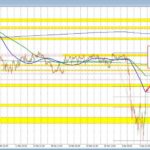
USD/CHF Currency Analysis: Navigating Key Resistance Levels and Market Trends
Tháng 4 7, 2025
Navigating Economic Turbulence: Larry Fink’s Insights on Recession and Market Trends
Tháng 4 7, 2025Larry Fink’s Insight on Tariffs and Inflation: Understanding Their Economic Impact
The recent dialogues led by Larry Fink, the CEO of BlackRock, echo the growing discord surrounding the effects of tariffs and inflation in the current economic landscape. As Fink articulates, the worries concerning a potential recession are more pronounced than ever, primarily due to uncertainties stemming from U.S. President Donald Trump’s tariff policies. In conversations across the industry, Fink notes that the underlying sentiment is drastically tinged with anxiety, primarily fueled by inflationary pressures and the inherent instability in the economy.
The Prelude to Economic Anxiety: Tariffs and Their Implications
The crux of the concern lies in the tariff policies that have stirred apprehension among market players. Fink has regularly pointed out that discussions related to these tariffs often reflect a palpable sense of dread about potential economic downturns. The realities of these tariffs resonate beyond mere trade figures and impact everyday consumers and businesses. They lead to increased input costs for manufacturers, which ultimately drive up prices for consumers. This inflationary spiral could spell stagnation in economic growth if businesses are unable to absorb these additional costs or pass them onto consumers.
Jamie Dimon, the CEO of JPMorgan Chase, has mirrored Fink’s concerns by highlighting how these tariffs could further elevate domestic prices. The fear is that the accumulation of input costs may cause companies to reconsider their expansion strategies, which can cause a chain reaction resulting in a slowdown in domestic economic activity. As both Fink and Dimon unify their voices on the repercussions of protectionist measures, it becomes clear that a consensus is forming around the belief that these policies do more harm than good.
For a deeper understanding of China’s strategic economic moves and their implications amidst U.S.-China trade tensions, you can explore more in the Three Strategic Moves by China blog.
Adapting Investment Strategies in the Face of Economic Instabilities
In an environment characterized by uncertainty, Fink suggests a recalibration of traditional investment strategies. His proposal involves a shift from the conventional 60/40 stock-to-bond model to a 50/30/20 allocation that introduces a greater focus on alternative investments such as real estate and infrastructure. This strategic pivot not only aims to optimize returns but also serves to diversify portfolios in a way that can better weather inflationary pressures.
The rationale behind this adjustment is clear; by embracing alternative investments, investors can fortify their portfolios against the vicissitudes of an unpredictable market characterized by tariffs and rising costs. This proactive approach seeks to mitigate risks while leveraging opportunities in sectors that may yield better returns despite pervasive economic challenges.
Conclusion: The Path Forward
As Fink’s remarks resonate through the financial community, they encapsulate a broader sentiment of caution and strategic adjustment in response to the volatile economic landscape. The implications of tariffs and inflation are significant, and addressing these concerns requires both awareness and adaptability. Investment strategies that anticipate the shifting rhythms of the economy may just be the key to navigating through these tumultuous times successfully. The insights from industry leaders like Larry Fink and Jamie Dimon urge us to remain vigilant and informed about the economic factors that shape our financial futures. With these strategies in mind, investors can take informed steps to not only survive but thrive amidst uncertainty.

